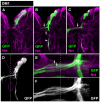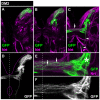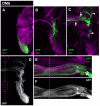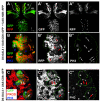Postembryonic development of transit amplifying neuroblast lineages in the Drosophila brain
- PMID: 20003348
- PMCID: PMC2801669
- DOI: 10.1186/1749-8104-4-44
Postembryonic development of transit amplifying neuroblast lineages in the Drosophila brain
Abstract
Background: Specific dorsomedial (DM) neuroblast lineages of the Drosophila brain amplify their proliferation through generation of transit amplifying intermediate progenitor cells. Together, these DM neuroblast lineages comprise over 5,000 adult-specific neural cells and thus represent a substantial part of the brain. However, no information is currently available about the structure or function of any of the neural cells in these DM lineages. In this report we use MARCM-based clonal analysis together with immunocytochemical labeling techniques to investigate the type and fate of neural cells generated in the DM lineages.
Results: Genetic cell lineage-tracing and immunocytochemical marker analysis reveal that DM neuroblasts are multipotent progenitors that produce a set of postembryonic brain glia as well as a large number of adult-specific protocerebral neurons. During larval development the adult-specific neurons of each DM lineage form several spatially separated axonal fascicles, some of which project along larval brain commissural structures that are primordia of midline neuropile. By taking advantage of a specific Gal4 reporter line, the DM-derived neuronal cells can be identified and followed into early pupal stages. During pupal development the neurons of the DM lineages arborize in many parts of the brain and contribute to neuropile substructures of the developing central complex, such as the fan-shaped body, noduli and protocerebral bridge.
Conclusions: Our findings provide cellular and molecular evidence for the fact that DM neuroblasts are multipotent progenitors; thus, they represent the first identified progenitor cells in the fly brain that have neuroglioblast functions during postembryonic development. Moreover, our results demonstrate that the adult-specific neurons of the DM lineages arborize widely in the brain and also make a major contribution to the developing central complex. These findings suggest that the amplification of proliferation that characterizes DM lineages may be an important requirement for generating the large number of neurons required in highly complex neuropile structures such as the central complex in the Drosophila brain.
Figures










Similar articles
-
Programmed cell death in type II neuroblast lineages is required for central complex development in the Drosophila brain.Neural Dev. 2012 Jan 18;7:3. doi: 10.1186/1749-8104-7-3. Neural Dev. 2012. PMID: 22257485 Free PMC article.
-
Multipotent neural stem cells generate glial cells of the central complex through transit amplifying intermediate progenitors in Drosophila brain development.Dev Biol. 2011 Aug 15;356(2):553-65. doi: 10.1016/j.ydbio.2011.06.013. Epub 2011 Jun 25. Dev Biol. 2011. PMID: 21708145
-
Early-born neurons in type II neuroblast lineages establish a larval primordium and integrate into adult circuitry during central complex development in Drosophila.Neural Dev. 2013 Apr 23;8:6. doi: 10.1186/1749-8104-8-6. Neural Dev. 2013. PMID: 23618231 Free PMC article.
-
The development of the Drosophila larval brain.Adv Exp Med Biol. 2008;628:1-31. doi: 10.1007/978-0-387-78261-4_1. Adv Exp Med Biol. 2008. PMID: 18683635 Review.
-
Regulating neural proliferation in the Drosophila CNS.Curr Opin Neurobiol. 2010 Feb;20(1):50-7. doi: 10.1016/j.conb.2009.12.005. Epub 2010 Jan 14. Curr Opin Neurobiol. 2010. PMID: 20079625 Review.
Cited by
-
Programmed cell death in type II neuroblast lineages is required for central complex development in the Drosophila brain.Neural Dev. 2012 Jan 18;7:3. doi: 10.1186/1749-8104-7-3. Neural Dev. 2012. PMID: 22257485 Free PMC article.
-
Postembryonic lineages of the Drosophila brain: II. Identification of lineage projection patterns based on MARCM clones.Dev Biol. 2013 Dec 15;384(2):258-89. doi: 10.1016/j.ydbio.2013.07.009. Epub 2013 Jul 18. Dev Biol. 2013. PMID: 23872236 Free PMC article.
-
Origin and development of neuropil glia of the Drosophila larval and adult brain: Two distinct glial populations derived from separate progenitors.Dev Biol. 2015 Aug 15;404(2):2-20. doi: 10.1016/j.ydbio.2015.03.004. Epub 2015 Mar 14. Dev Biol. 2015. PMID: 25779704 Free PMC article.
-
Diverse neuronal lineages make stereotyped contributions to the Drosophila locomotor control center, the central complex.J Comp Neurol. 2013 Aug 15;521(12):2645-Spc1. doi: 10.1002/cne.23339. J Comp Neurol. 2013. PMID: 23696496 Free PMC article.
-
Functional analysis of enhancer elements regulating the expression of the Drosophila homeodomain transcription factor DRx by gene targeting.Hereditas. 2021 Nov 5;158(1):42. doi: 10.1186/s41065-021-00210-z. Hereditas. 2021. PMID: 34736520 Free PMC article.
References
-
- Urbach R, Technau GM. Neuroblast formation and patterning during early brain development in Drosophila. Bioessays. 2004;26:739–751. - PubMed
-
- Hartenstein V, Spindler S, Pereanu W, Fung S. The development of the Drosophila larval brain. Adv Exp Med Biol. 2008;628:1–31. - PubMed
-
- Skeath JB, Thor S. Genetic control of Drosophila nerve cord development. Curr Opin Neurobiol. 2003;13:8–15. - PubMed
-
- Technau GM, Berger C, Urbach R. Generation of cell diversity and segmental pattern in the embryonic central nervous system of Drosophila. Dev Dyn. 2006;235:861–869. - PubMed
Publication types
MeSH terms
LinkOut - more resources
Full Text Sources
Medical
Molecular Biology Databases

